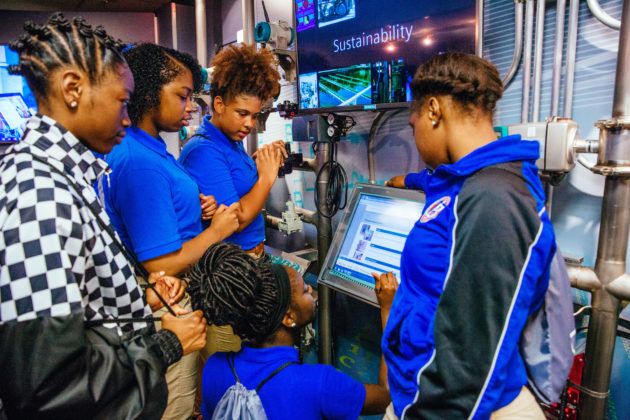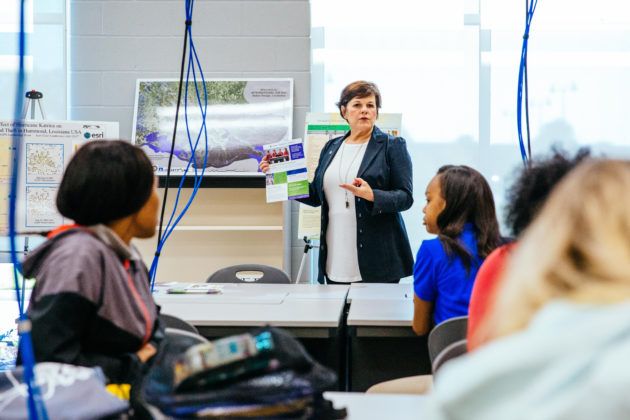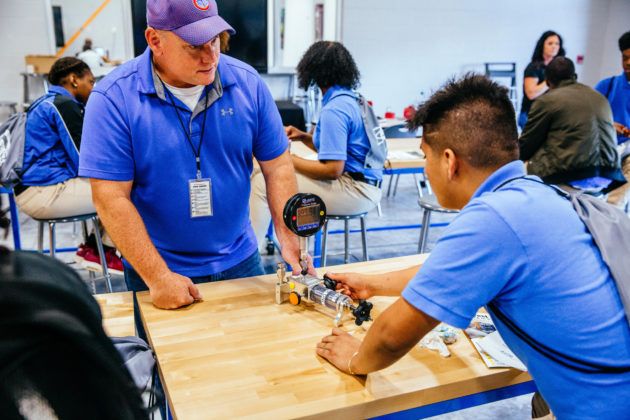Trey Crawford is vice president of Grady Crawford Construction and chairman of Associated Builders and Contractors-Pelican Chapter. Through his own company’s experience and his work with ABC, he knows as well as anyone how hard it is to get young people interested in the industrial crafts.
“We see a lack of enthusiasm for construction jobs, and that’s a major problem,” Crawford says.
For some young people, he suggests, finding their way into a training program for a good job as a welder or pipefitter might be literally life-saving, or at least life-changing.
“We’re trying to get these kids off the streets,” Crawford says. “We need engaged talent.”
When Ronnie Gulino, director of field services for ISC, was a teenager, every school had industrial arts, he says. But many of those programs were phased out as schools focused on preparing students for four-year college degrees.
“We’re reaping those ills now,” he says. “I think it’s getting better, but we’ve gotten so far behind the eight-ball that it’s going to take a while to catch up.”
While there may not be a silver bullet, ABC wants to be part of a solution. The association runs two craft training centers—one in Baton Rouge and one in Westlake—that serve about 500 high school students a year. The students spend half of their day at their traditional schools and half with ABC.
It’s one of several efforts to blend traditional classroom instruction with industry training, hopefully leading to good jobs for Louisiana residents and adding to the pipeline of qualified South Louisiana workers.
None of those efforts are larger or more important than Jump Start, the Louisiana Department of Education’s new career and technical education initiative.
“Jump Start has been a huge success,” says David Helveston, president and CEO of ABC-Pelican Chapter.
Before 2014, only about 2% of Louisiana high school students earned a diploma through the career and technical education pathway, says Ken Bradford, an assistant superintendent with the Department of Education. Many of them were poor, over-aged and under-credited, he says.
By law, students not proficient in English or math in the eighth grade were put on the “career” diploma path.
“It was very stigmatized,” Bradford says.
Starting with the 2014/2015 school year, school systems, partnering with industry and higher education, offered a new set of career pathways. Students now have more than 50 career concentrations to choose from. Each pathway includes nine courses culminating in a workforce credential relevant to a high-wage career in demand in their region.
At the end of grade 10, students decide whether they want to follow a career-diploma pathway or a TOPS-focused pathway meant to lead to a university education. About 8,400 of the roughly 40,000 students who graduated from Louisiana high schools this year earned career diplomas, Bradford says.
Schools now are rewarded for helping students earn career credentials in their accountability scores. How the craft training is delivered varies by region.
For example, Ascension Parish students are bused to ABC’s Baton Rouge training center. For systems that don’t have a similar partner, the state may train their teachers over the summer to deliver the craft curriculum.
This year almost 2,000 high school students participated in Jump Start Summers, earning academic credit, doing workplace-based learning and attaining industry credentials, all while earning a wage.
“It was the most popular program I’ve ever worked with,” says Stephanie Marcum, senior educational technology consultant with the Department of Education.
In September, the newly opened EBR Career and Technical Education Center, part of the East Baton Rouge Parish school system, held Career & Tech day. About 300 high school sophomores heard about available jobs from 10 area companies, says Summer Dann, the center’s executive director.
EBR CTEC offers training for juniors and seniors in computer science, health care, construction and manufacturing. So how popular are the industrial classes?
“They aren’t, which is a problem,” Dann says. “For a very long time, it’s been pushed that a four-year university degree is the only way to be successful, which really isn’t true.”
About a quarter of her 112 students, who spend a half day at CTEC, are in manufacturing or construction, she says. The center can accommodate up to 300 students in its current state and modular buildings could be added if needed and funds are available.
Dann, who has worked for LSU and ITI Technical College, mined her professional network to find retired craftspeople who could become instructors. But in general, qualified instructors in the industrial crafts are difficult to attract and retain.
“A good one is hard to find,” says Lucy Lejeune, who directs career and technical education for Jefferson Parish Public Schools. “If you’re good at welding, you’re going to be a welder. You’re not going to take a lower-paying job to show kids how to weld.” And even if you want to teach, she adds, you might not know how to manage a classroom.
Many students don’t want to leave their home school for half of the day, Lejeune says. Jefferson Parish is considering a comprehensive career and technical education high school, which Lejeune says would be “awesome.”
“You can’t separate academics at one school and send them to career and tech ed in another,” Lejeune argues. “It’s got to be integrated.”
For small and rural districts, finding industry partners that help ensure their training is relevant and up to date can be a challenge. Jefferson Davis Parish schools partner with ABC-Pelican, which in turn connects them with companies such as Turner Industries and Sasol.
“We’ve had a good response from them, because they know that these students are their future employees,” says Danielle Simien, who supervises career and technical education for the Jeff Davis system.
A big part of overcoming the stigma is just making sure students, parents and guidance counselors know what’s out there.
“[Students] really don’t know what the jobs are,” says Sarah Haneline, workforce development and communications specialist with BASF. “The students say, ‘I want to go work in the plants.’ But they really have no idea what that means.”
To that end, BASF created TECH Academy, a summer camp for high school students who spend half of the day at River Parishes Community College and half at companies such as ISC, Emerson Technologies, BASF and Anvil Attachments.
Since its inception in 2015, 125 students have graduated TECH Academy with interest in pursuing a tech career. At the end of this year, BASF may hire process technology interns and full-time PTEC positions from the TECH Academy pipeline of students, Haneline says.
About two years ago, members of the Westbank Business & Industry Association approached Jefferson Parish school officials to ask why they weren’t producing more workforce-ready graduates, says WBIA Executive Director Lisa Jennings. Those conversations led to WBIA business leaders becoming advisors for the schools’ career training programs.
“They can come and hand-pick kids as they finish the programs and put them straight into work,” Jennings says.
Not every student has the interest, skills and money to obtain a four-year degree, she notes.
And she says university-bound students also can benefit from the real-world critical thinking skills that career and technical education promotes.
“Every student should be doing career tech,” Jennings says.














